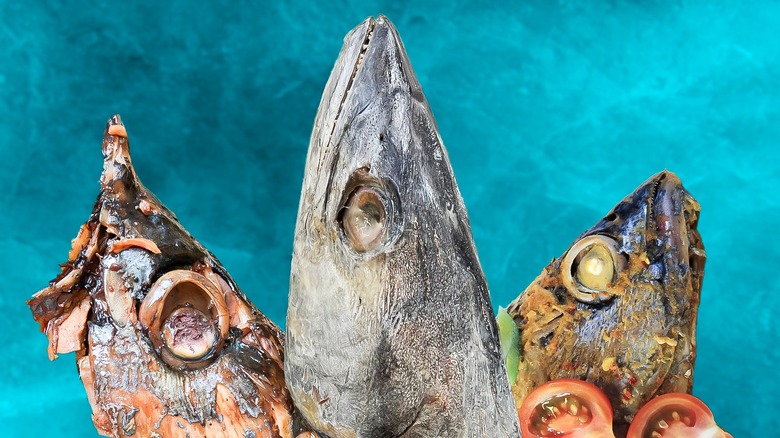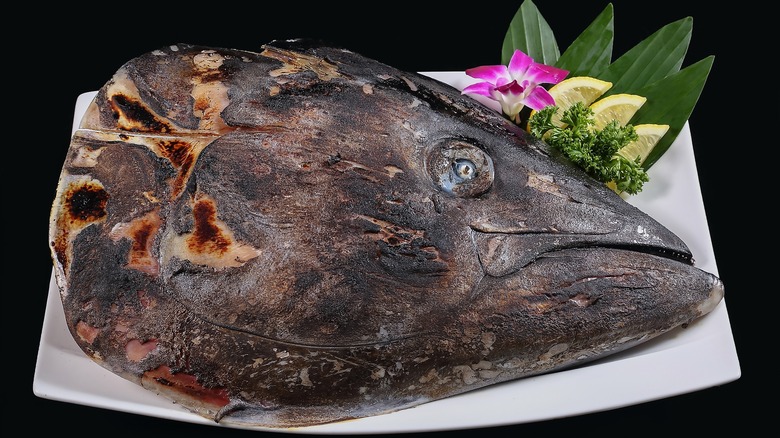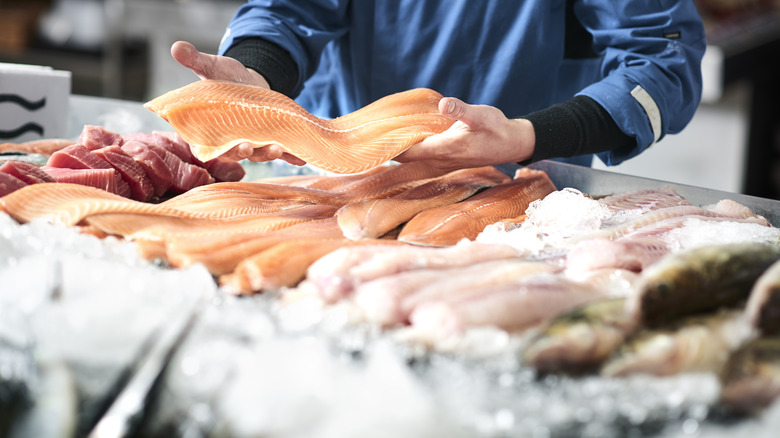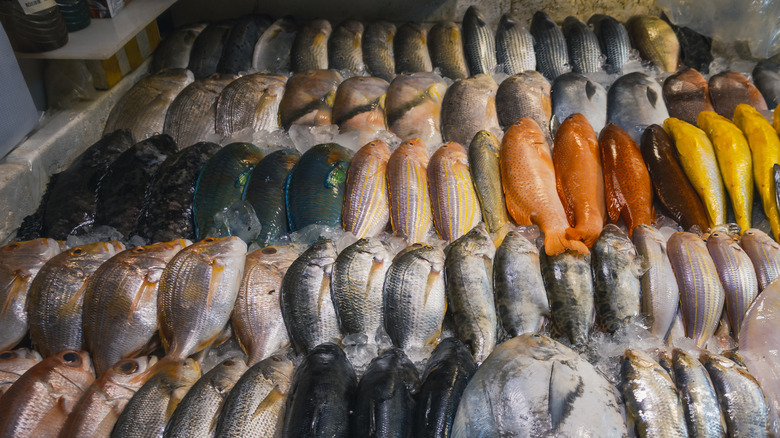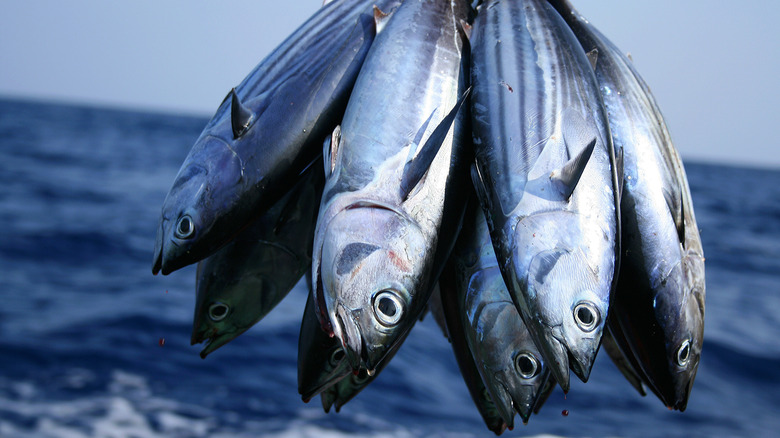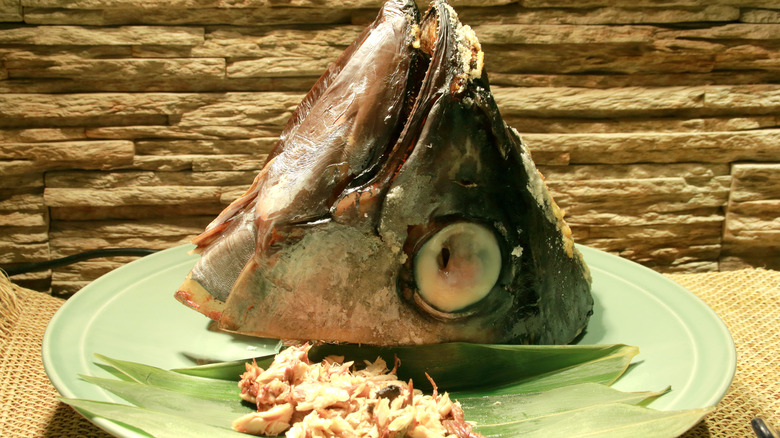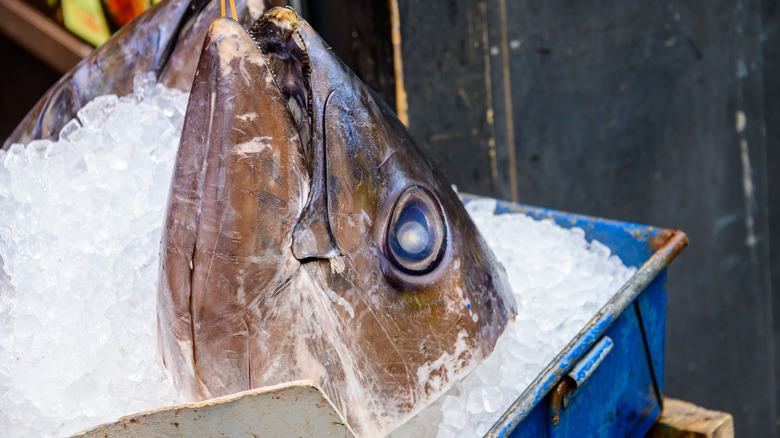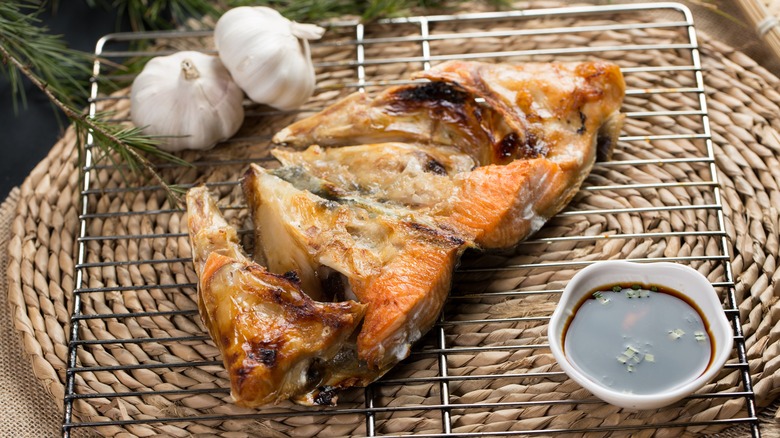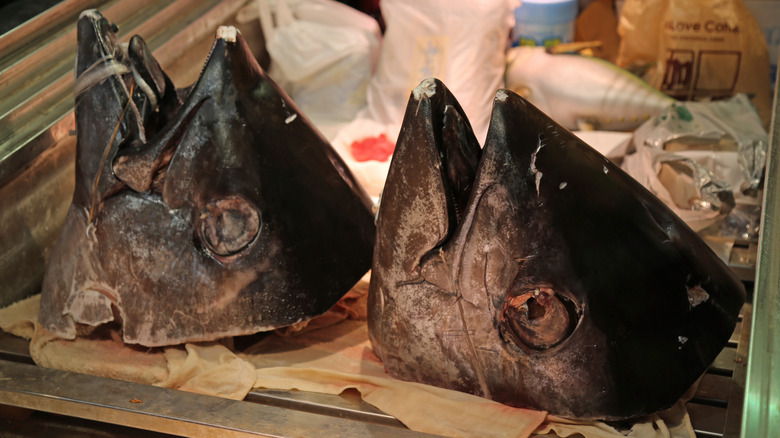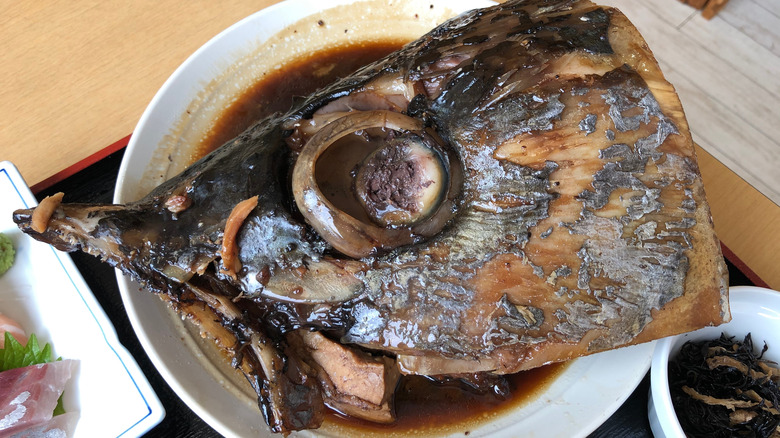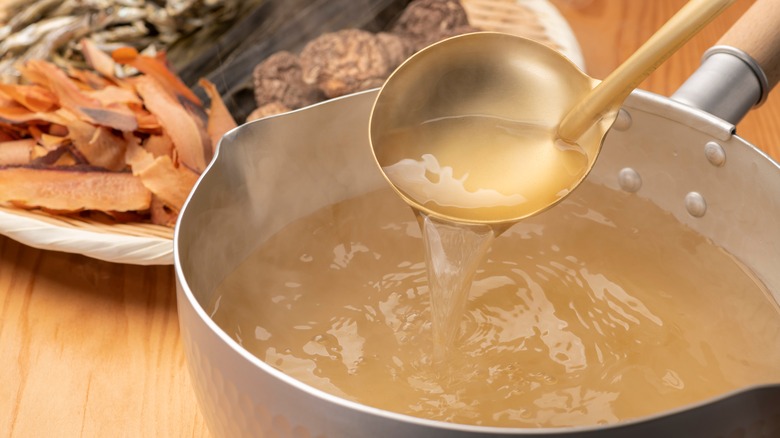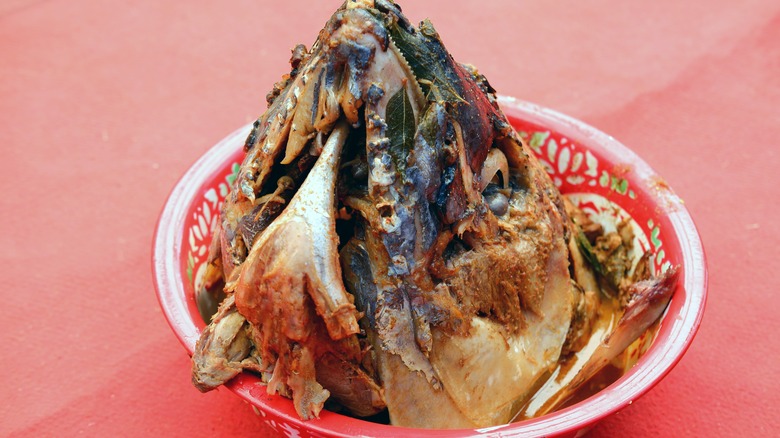Tuna Heads Are The Underrated Fish Cut You Need To Try
Tuna fish is a popular canned food that graces many grocery store shelves. You'll also find fresh tuna filets in the butcher case and frozen tuna steaks in the freezer section. While these are the most frequently eaten choices, the meat comes from the body of the tuna. But the head features a lot of meat, as well, and is often overlooked. As a result, it may not even register on your fishy radar as good eats. This underrated cut of tuna is a shame to waste, though, and who knows, it could become your new favorite cut of fish.
To help us guide you through the ins and outs of a tuna's head, we spoke with celebrity chef and fisherman, Andrew Zimmern, about what it takes to enjoy this somewhat rare delicacy, from sustainably sourcing it to serving it with Asian-inspired condiments and sides. When tuna is processed, the head typically gets tossed aside and forgotten, at least here in the U.S. "I think that Americans have unfairly relegated [fish heads] to the dustbin of food," says Zimmern. As one of his favorite dishes, the head of a tuna is a go-to cut of fish for Zimmern, whether he's overseas or at home in the States. "Fish head soups are popular all over the world. Fish head stews are popular all over the world," he tells us.
Tuna heads and all the edible parts
The head of a tuna consists of multiple cuts — cheeks, collar, and eyes — but Andrew Zimmern explains that the head is not typically divided into these cuts. Because the head is made up of pockets of muscles between the bones, trying to access certain cuts like the cheeks means you lose out on multiple pounds of meat found throughout the head. And if you're going to shop for cuts from the tuna head, you're better off obtaining the entire head anyway. It's often thrown away or sold fairly cheaply.
"The majority of the meat," Zimmern tells us, "is around the collar or what would be the neck of the animal, but then you have all of those incredible cuts from the cheeks to the muscles behind the eyes to my favorite cut," which he says is "a round ball of meat where the jaws link together." He feels this particular cut is just incredible. If you attempt to source individual cuts from the head, you're going to miss out on the variety of flavors and textures that come from one tuna head. A large part of enjoying the head lies in cooking it whole in order to achieve the best the meat has to offer.
Why it may be difficult to find tuna heads
With all the delicious meat found on the head of a tuna, it may be surprising to learn it can be difficult to find in U.S. grocery stores or butcher shops. Why is that? In America, fish heads are considered to be a by-product that is typically thrown out, used as livestock feed, or bait for catching other fish. For this reason, if you can contact your local fisherman to inquire about getting a tuna head for your next dinner party, you just might get one for free.
Tuna sold in the U.S. often comes in the form of filets and steaks, and of course, it's sold by some of the best canned tuna brands. These cuts all come from the body of a tuna, leaving the tail and head to be cast aside. Without a high demand for either the head or tail, you neither see them offered in American stores or restaurants nor as an ingredient in many tuna recipes. What you do find are, as Andrew Zimmern tells us, "all the akami from the top loins of the tuna and part of the bottom loins, and then all the toro [such as otoro and chutoro] and fattier pieces," which are frequently found in sushi and sashimi.
Sustainably sourcing tuna heads
Though the head of a tuna may not be readily available via your neighborhood store, that doesn't mean you can't source it — and do so responsibly. The best way to find a tuna head is to simply ask your local fishmonger. How to find the most reliable fishmonger? Look for a local fish store that always seems to have a line outside the door.
Andrew Zimmern points out that most fishmongers receive tuna in its entirety and butcher it themselves, though they may never display the head in the viewing case. You'll have to ask for it specifically. "Ask your fishmonger if the next time they bring in tuna they can include some heads for you, or a head if it's coming from a very large fish," he suggests. Otherwise, it may be an item you have to special order.
Alternatively, if you live on the Pacific or East coast, you may be able to visit the fishing docks or nearby fish markets where tuna boats come in, to inquire about sourcing tuna heads directly from fishermen. In many coastal fishing communities, you should be able to find large tuna heads, according to Zimmern.
Different varieties of tuna
Part of the biological tribe Thunnini, eight species of tuna reside within the Thunnus genus of fishes and are referred to as the true tunas. But not all eight varieties of true tuna are meant to be on your plate. You're probably most familiar with albacore and skipjack — two popular varieties that are the best for making tuna salad, but there also exist yellowfin, bigeye, bluefin, and blackfin, which are varieties sometimes used in tuna steak recipes. Andrew Zimmern warns against the over-fishing of bluefin tuna, though, confiding, "I believe the giant bluefin tuna is something that we shouldn't be eating these days. We need to lay it off for a while, so we can understand more about what's going on with the shrinking stocks of that fish."
Which variety has the best tuna heads for eating? According to Zimmern, yellowfin tuna heads get super large and usually come from sustainable fisheries. But even a smaller tuna, like blackfin, can grow up to about 20 pounds and feature a sizable head that Zimmern says is "absolutely out-of-control good" when roasted. As far as the difference between varieties, the taste and texture of the head is basically the same.
The unforgettable flavor of tuna heads
If you think the head of a tuna has meat that's similar to the body, you'd be mistaken. The body is much leaner than the head and they taste nothing alike. Andrew Zimmern tells us, "It's kind of like, all the berry flavors are in the body of the tuna and all the citrus flavors are in the head; it's that different." And since tuna features different types of muscle all over the head, the various parts of the head vary in flavor and texture as well. "The meat from the head is more like the meat from a fish collar, if you've eaten those before — super moist, very dense, [and] concentrated flavor," he explains.
If you think about how this pelagic fish eats, as Zimmern mentions, and all the muscles involved as the tuna uses its jaws, you'll understand the large amount of muscle that's found in the head. In addition to the muscles, the larger amounts of fat also found in the head create a mouth-watering experience that shouldn't be missed. In fact, the tuna's cheeks, called Hoho-niku in Japanese, are often described as the filet mignon of tuna, and deliver a hearty, yet tender bite of fish. And, Zimmern says, "Because you're cooking it all the way through and not eating it raw, it has incredible, incredible texture [and] just melts in your mouth."
Fresh or frozen
Chances are high that when you source the head of a tuna from your local fishmonger, it will be fresh and not frozen. And your best bet, Andrew Zimmern advises, is to keep it fresh and cook it right away. This will give you the best results; freezing fish drastically changes the quality of the meat, and it could end up with a rubbery texture. Besides, as Zimmern notes, tuna heads can get so big that it could take far too long to defrost if you do freeze them.
But what if you manage to score multiple tuna heads? What's the best way to freeze them and how long do they last? If you're lucky enough to have multiple tuna heads staring back at you, the best option is to vacuum-seal the extra heads to keep out as much air as possible. Though they may last for a couple of months, there's no guarantee they'll still be fresh enough for you to enjoy them. Keep an eye out for discoloration or slime, and use your nose to check for any rancid odor. All these signs indicate your fish has gone bad.
There's really only one way to eat it
While many tuna cuts are enjoyed raw or cooked — from sushi to seared — there's really only one way to enjoy tuna head meat, according to Andrew Zimmern. "Whether it's your first time or your last time," he says, "roasting it is the way to go." You can use your oven or indirect heat on a kamado grill, but he recommends considering the size of the head. "I usually put it in my oven with the tip of the tuna head at the top of the oven, so it may not fit on a lot of conventional grills," Zimmern says. "Indirect heating on a barbecue setup or grill setup, you're gonna need to have one with a very large dome."
Are you out of luck if your tuna head doesn't fit with your oven or grill? Certainly not. "I know of places that take a really big cleaver and a mallet and split [the head] down the center, and roast it that way, or grill it." Regardless of how you roast it, Zimmern cooks the head until the internal temperature of the meat reaches 160 F in the deepest part. The reason, he says, is because the head is very dense, but there's little concern about overcooking the parts that are rich and fatty. "You don't have to worry about cooking them a little longer the way you do with a big turkey," he explains.
Keep it simple for best results
Tuna meat shines when preparation is kept simple, whether you're doing tuna steaks on the grill or roasting an entire tuna head. Andrew Zimmern suggests you should let the meat speak for itself. Though the taste of tuna pairs well with a number of seasonings, there's really no need for marinades or rubs — Zimmern seasons a tuna head with just salt, "so that I can enjoy that singular, delicate flavor of the meat." Bring the tuna head up to room temperature if you've kept it in the fridge for any length of time. Then wash it under running water and pat it dry before adding a liberal amount of salt all over the exterior of the head.
The cooking process is every bit as simple as the preparation process. Place your salted tuna head on a large rack with a drip pan and put it in the oven. "I always just high-heat roast it," Zimmern tells us. "It's an absolute joy." Roast the tuna head at 400 F for roughly an hour and a half, depending on size, until the internal temperature of the deepest part of the head registers 160 F — and don't forget to let it rest before you serve it.
Serve it with a variety of condiments and sides
You don't want to over-season your tuna head when you cook it, so that you can fully appreciate the taste of the meat. But you do want to serve it up alongside some condiments and sides, which allows you to enjoy it with complementary flavors. Andrew Zimmern lets us in on his favorite way to serve tuna head: He likes to "bring it on a platter into the dining room, pull apart the jaws — they separate — and then everyone kind of has at all the different pieces using spoons and chopsticks. It's very easy as you break it apart."
Serving roasted tuna head with condiments or side dishes lets you and your guests sample various tastes and textures. Consider a mixture of lemon juice and some good-quality soy sauce in a 2 to 1 ratio, together with grated daikon radish, scallions, and togarashi for dipping forkfuls of tender tuna head meat. Another suggestion, as Zimmern mentions, "I now serve [roasted tuna head] with dozens of Japanese, Korean, and Chinese pickles, sort of like bonchon style, with big bowls of rice — and it's just one of the best meals ever."
Use the bones and skin for stock
Tuna heads don't just come with a lot of meat on them. They're also full of bones and cartilage, a connective tissue that contains a fair amount of collagen, glucosamine, and chondroitin, Andrew Zimmern explains. This combination creates a great base for making a delicious fish stock. All parts of the raw tuna head can be used to simmer stock, which will give you a deep, flavorful broth. And if you happen to obtain multiple heads, you can use one to create the stock and the other as the main ingredient for your recipe.
Alternatively, throw together a soup or stew with the leftover pieces of your roasted tuna head — but hang onto the roasted skin and bones, which can lend a rich taste to your base as it simmers. Just be sure to strain the broth before adding in your other ingredients. Then add your shredded roasted tuna head meat to complete your soup. No matter what you choose to do, Zimmern says, "If you get your hands on a tuna head, I can't recommend it enough."
Be on the lookout if you're traveling overseas
Tuna heads are a lot more common overseas and are frequently found in Japanese restaurants, according to Andrew Zimmern. "If you go to any of the villages where there's lots of tuna boats, [many of] the local restaurants specialize in roasting tuna heads." So, although cooking a tuna head at home in America may be a once-in-a-lifetime meal, it's a regular staple for meals in places like Japan, Korea, and the Philippines. If you find yourself traveling to other countries, keep an eye out for this popular and delectable dish at local restaurants.
Zimmern has experienced this delicious delicacy more than a dozen times in his travels, noting that one of his top ten dishes of all time comes from a restaurant in Singapore, which he explains "is a hybridized Singaporean, Straits Malay, Indian restaurant that serves an entire meal based around these big fish heads where everybody gets their own head, and lots of accouterment, served on a banana leaf."
